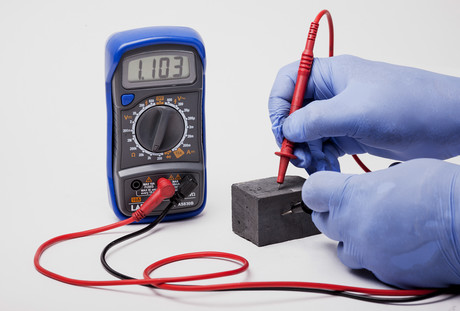Graphene-infused concrete can conduct electricity

Australian advanced materials company Talga Resources has achieved high levels of electrical conductivity in concrete by using an additive developed from the company’s graphene-graphite research and development laboratory in the UK.
The breakthrough offers substantial potential in existing and emerging industrial applications, particularly as concrete is the world’s largest construction material by volume and worth over US$450 billion per year.
Tests
The concrete samples were manufactured at Talga’s German process test facility and the Betotech (Heidelberg Cement Q&C) laboratory in Germany using industry-standard cement with additions of Talga’s graphene, graphite and silica-rich by-product of ore processing. The optimised formulation targeted high electrical percolation at low material concentrations and with potentially lower cost factors.
The samples were tested in-house by a European industrial partner and further measurements were undertaken by Professor Ian Kinloch’s group at the University of Manchester (UoM). In the UoM study, the conductivity of samples was measured using electrical impedance spectroscopy in both through-plane and in-plane directions over a range of frequencies. For reference, a standard mortar (without Talga additives or aggregates) was used. A summary of results is shown in the table below.
| Specimen | Conductivity (siemens/cm) | Resistivity (ohm-cm) |
| Talga concrete | 20 | 0.05 |
| Standard mortar | 0.000001 | 1,000,000 |
The UoM tests recorded the Talga graphene-enhanced concrete had high electrical conductivity (low resistivity) to 0.05 ohm-cm. Ohm is the measure of a material’s resistance to conduct electricity — the lower the better. This rating compares to a general resistivity level of around 1,000,000 ohm-cm for the reference mortar.
The results have also shown the silica-rich by-product of ore processing is remarkably conductive in itself, tough and highly suitable for use in construction materials. Trial concrete products developed by Talga are targeting the innovative use of this material, thereby increasing potential economic benefits and sustainability of the future Swedish operation.
Applications
As concrete is effectively an insulator in a dry state, adding the function of high electrical conductivity has been a goal of material scientists for a long time. Previous attempts typically relied on the addition of high loadings of magnetite (iron), steel fibres, synthetic and natural carbons (including graphite) but did not achieve high levels of performance. In addition, the required (high) loadings of active materials tended to cause negative effects on cost, strength, corrosion and abrasion resistance, maintenance costs and weight.
The electrically conductive ‘graphene concrete’ has applications in current markets such as underfloor heating, where it can provide a long-term, low-maintenance alternative to plumbed hot water installations. Other current applications include the provision of antistatic flooring and EMI shielding (radiofrequency interference) in buildings, and cost-effective grounding and lightning strike protection for a range of infrastructure from bridges to wind turbines.

Additionally, as a ‘solid state heater’ the technology may enable more rapid and environmentally friendly ways of clearing ice and snow from key transport routes and airports compared to the cost of ploughs, salt, de-icing chemicals and wastewater treatment of chemical run-off.

In future, Talga will investigate the potential of the electrically conductive concrete for a cost-effective role in enabling inductive (wireless) charging technologies for electric vehicles under dynamic (driving) as well as stationary (parking) conditions through the increased range of heating, sensing and other conductive concrete functions.

Markets and next steps
Talga’s commercialisation strategy is focused on targeted value-added graphene and graphite products covering the energy, coatings, composites and construction sectors. Initial partner work and customer testing is already underway on:
- lithium-ion batteries and a range of energy storage technologies;
- metal pre-treatment, marine epoxy and other coatings;
- cement/concrete additives;
- epoxy resins for carbon fibre (composites).
These applications and products have been developed over the past two years with global-scale industrial and R&D partners, using high-grade graphite ore liberated in successful trial mining from Talga’s deposits in north Sweden.
Talga currently has an MoU with the world’s second largest concrete manufacturer, Heidelberg Cement, focused on thermally conductive concrete, but is free to explore other market opportunities. The company is currently recruiting a European-based commercial team that will include construction sector and concrete market experience, to use these test results in commercialisation discussions with a range of industrial partners.
“This type of concrete has some exciting and large-volume applications, and in some cases can combine with our thermally conductive concrete,” said Talga Managing Director Mark Thompson.
“Furthermore, the conductivity is achieved with a very low loading of our graphene, but a larger amount of ore processing by-products, providing maximum potential for the most cost-effective, scalable and eco-friendly development options.”
Electric dump valves help oil and gas company reduce emissions
Oil and gas company Laramie Energy deployed ASCO zero-emissions electric dump valves to comply...
Australia's largest electronics expo returns to Sydney
Electronex, the annual electronics design and assembly expo, will return to Sydney on 19–20...
The fundamentals of Australian RCM compliance
The following information aims to help readers understand the Australian compliance requirements...





